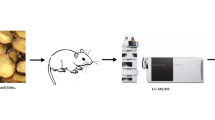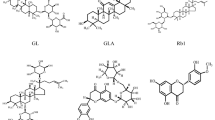Abstract
Paeoniae Radix, a traditional herbal medicine, has been used in antispasmodic action, alleviating pain, and activating circulation. The aim of this study was to evaluate the pharmacokinetics (PKs) of paeoniflorin in healthy Korean subjects and develop an analytical method for the quantification of paeoniflorin in human plasma. This was an open-label, randomized, and single-dose study in 10 healthy Korean subjects who received a Paeoniae Radix extract powder. The plasma concentration of paeoniflorin up to 12 h was determined using a validated ultra-performance liquid chromatography tandem mass spectrometric method. The PK parameters such as AUC0−∞, CL/F, Vd/F, Cmax, Tmax and t1/2 were calculated using WinNonlin® software (version 6.4, Pharsight®, a Certara™ Company). The best PK model of paeoniflorin in humans was the one-compartment model. The mean parameters were 2625.71 L/h, 10,150.55 L, 6.97 ng/mL, and 1.64 h for the oral clearance (CL/F), the volume of distribution (Vd/F), the maximum plasma concentration (Cmax), and the time to reach Cmax(Tmax), respectively. The elimination half-life (t1/2) was 2.68 h. The validated method was successfully applied to the PK study of paeoniflorin in humans. The lower limit of quantification for paeoniflorin in human plasma was 0.2 ng/mL. This study was the first to evaluate the PKs of paeoniflorin after the usual oral dose of Paeoniae Radix extract powder (3.4 g containing 108.18 mg paeoniflorin) in Korean subjects.




Similar content being viewed by others
References
Ahmad L, Semotiuk A, Zafar M, Ahmad M, Sultana S, Liu QR, Zada MP, Abidin SZ, Yaseen G (2015) Ethnopharmacological documentation of medicinal plants used for hypertension among the local communities of DIR Lower, Pakistan. J Ethnopharmacol 175:138–146
Ai Y, Wu Y, Wang F, Ma W, Bian Q, Lee DY, Dai R (2015) A UPLC-MS/MS method for simultaneous quantitation of three monoterpene glycosides and four alkaloids in rat plasma: application to a comparative pharmacokinetic study of Huo Luo Xiao Ling Dan and single herb extract. J Mass Spectrom 50(3):567–577
Chen YF, Wu KJ, Wood WG (2013) Paeonia lactiflora extract attenuating cerebral ischemia and arterial intimal hyperplasia is mediated by paeoniflorin via modulation of VSMC migration and Ras/MEK/ERK signaling pathway. Evid Based Complement Altern Med 2013:482428
Chen J, Chen Z, Ma L, Liang Q, Jia W, Pan Z, Zeng Y, Jiang B (2014) Development of determination of four analytes of Zhi-Shao-San decoction using LC-MS/MS and its application to comparative pharmacokinetics in normal and irritable bowel syndrome rat plasma. Biomed Chromatogr 28(10):1384–1392
Hu DD, Han QB, Zhong LL, Li YH, Lin CY, Ho HM, Zhang M, Lin SH, Zhao L, Huang T, Mi H, Tan HS, Xu HX, Bian ZX (2015) Simultaneous determination of ten compounds in rat plasma by UPLC-MS/MS: application in the pharmacokinetic study of Ma-Zi-Ren-Wan. J Chromatogr B Anal Technol Biomed Life Sci 1000:136–146
Jiang WL, Chen XG, Zhu HB, Gao YB, Tian JW, Fu FH (2009) Paeoniflorin inhibits systemic inflammation and improves survival in experimental sepsis. Basic Clin Pharmacol Toxicol 105(1):64–71
Jiang F, Zhao Y, Wang J, Wei S, Wei Z, Li R, Zhu Y, Sun Z, Xiao X (2012) Comparative pharmacokinetic study of paeoniflorin and albiflorin after oral administration of Radix Paeoniae Rubra in normal rats and the acute cholestasis hepatitis rats. Fitoterapia 83(2):415–421
Lee SM, Li ML, Tse YC, Leung SC, Lee MM, Tsui SK, Fung KP, Lee CY, Waye MM (2002) Paeoniae Radix, a Chinese herbal extract, inhibit hepatoma cells growth by inducing apoptosis in a p53 independent pathway. Life Sci 71(19):2267–2277
Li H, Ren P, Huang X, Tang WF, Wei HQ (2008) Simultaneous determination and pharmacokinetic studies of ferulic acid and paeoniflorin in human serum by high performance liquid chromatography after oral administration of modified Xiao-yao decoction. Zhong Xi Yi Jie He Xue Bao 6(11):1178–1183
Li T, Yan Z, Zhou C, Sun J, Jiang C, Yang X (2013) Simultaneous quantification of paeoniflorin, nobiletin, tangeretin, liquiritigenin, isoliquiritigenin, liquiritin and formononetin from Si-Ni-San extract in rat plasma and tissues by liquid chromatography-tandem mass spectrometry. Biomed Chromatogr 27(8):1041–1053
Li X, Shi F, Gu P, Liu L, He H, Ding L (2014) A sensitive LC-MS/MS method for simultaneous determination of amygdalin and paeoniflorin in human plasma and its application. J Pharm Biomed Anal 92:160–164
Liu ZQ, Jiang ZH, Chan K, Zhou H, Wong YF, Bian ZX, Xu HX, Liu L (2005) Pharmacokinetic interaction of paeoniflorin and sinomenine: pharmacokinetic parameters and tissue distribution characteristics in rats and protein binding ability in vitro. J Pharmacol Sci 99(4):381–391
Ni J, Yang D, Song L, Li C (2016) Protective effects of paeoniflorin on alveolar bone resorption and soft-tissue breakdown in experimental periodontitis. J Periodontal Res 51(2):257–264
Qiu J (2007) ‘Back to the future’ for Chinese herbal medicines. Nat Rev Drug Discov 6(7):506–507
Sadakane C, Watanabe J, Fukutake M, Nisimura H, Maemura K, Kase Y, Kono T (2015) Pharmacokinetic profiles of active components after oral administration of a Kampo medicine, Shakuyakukanzoto, to healthy adult Japanese volunteers. J Pharm Sci 104(11):3952–3959
Takeda S, Isono T, Wakui Y, Matsuzaki Y, Sasaki H, Amagaya S, Maruno M (1995) Absorption and excretion of paeoniflorin in rats. J Pharm Pharmacol 47(12A):1036–1040
Takeda S, Isono T, Wakui Y, Mizuhara Y, Amagaya S, Maruno M, Hattori M (1997) In-vivo assessment of extrahepatic metabolism of paeoniflorin in rats: relevance to intestinal floral metabolism. J Pharm Pharmacol 49(1):35–39
Tong L, Wan M, Zhou D, Gao J, Zhu Y, Bi K (2010) LC-MS/MS determination and pharmacokinetic study of albiflorin and paeoniflorin in rat plasma after oral administration of Radix Paeoniae Alba extract and Tang-Min-Ling-Wan. Biomed Chromatogr 24(12):1324–1331
US Food and Drug Administration, Department of Health and Human Services, Center for Drug Evaluation and Research, Guidance for Industry: Bioanalytical Method Validation, 2013
Wang L, Zhou GB, Liu P, Song JH, Liang Y, Yan XJ, Xu F, Wang BS, Mao JH, Shen ZX, Chen SJ, Chen Z (2008) Dissection of mechanisms of Chinese medicinal formula Realgar-Indigo naturalis as an effective treatment for promyelocytic leukemia. Proc Natl Acad Sci USA 105(12):4826–4831
Wang XY, Ma XH, Li W, Chu Y, Guo JH, Li SM, Wang JM, Zhang HC, Zhou SP, Zhu YH (2013a) Simultaneous determination of five phenolic components and paeoniflorin in rat plasma by liquid chromatography-tandem mass spectrometry and pharmacokinetic study after oral administration of Cerebralcare granule(®). J Pharm Biomed Anal 86:82–91
Wang Y, Xu C, Wang P, Lin X, Yang Y, Li D, Li H, Wu X, Liu H (2013b) Pharmacokinetic comparisons of different combinations of Shaoyao-Gancao-Decoction in rats: simultaneous determination of ten active constituents by HPLC-MS/MS. J Chromatogr B Anal Technol Biomed Life Sci 932:76–87
Yamahara J, Yamada T, Kimura H, Sawada T, Fujimura H (1982) Biologically active principles of crude drugs. II. Anti-allergic principles in “Shoseiryu-To” anti-inflammatory properties of paeoniflorin and its derivatives. J Pharmacobiodyn 5(11):921–929
Yan Y, Chai CZ, Wang DW, Wu J, Xiao HH, Huo LX, Zhu DN, Yu BY (2014) Simultaneous determination of puerarin, daidzin, daidzein, paeoniflorin, albiflorin, liquiritin and liquiritigenin in rat plasma and its application to a pharmacokinetic study of Ge-Gen decoction by a liquid chromatography-electrospray ionization-tandem mass spectrometry. J Pharm Biomed Anal 95:76–84
Yin D, Liu YY, Wang TX, Hu ZZ, Qu WM, Chen JF, Cheng NN, Huang ZL (2016) Paeoniflorin exerts analgesic and hypnotic effects via adenosine A1 receptors in a mouse neuropathic pain model. Psychopharmacology (Berl) 233(2):281–293
Zhang W, Dai SM (2012) Mechanisms involved in the therapeutic effects of Paeonia lactiflora Pallas in rheumatoid arthritis. Int Immunopharmacol 14(1):27–31
Zhang LG, Wang LJ, Shen QQ, Wang HF, Zhang Y, Shi CG, Zhang SC, Zhang MY (2015a) Paeoniflorin improves regional cerebral blood flow and suppresses inflammatory factors in the hippocampus of rats with vascular dementia. Chin J Integr Med. doi:10.1007/s11655-015-2124-3
Zhang Y, Qian D, Pan Y, Zhu Z, Huang J, Xi J, Guo J, Zhou X, Zhong G, Duan J (2015b) Comparisons of the pharmacokinetic profile of four bioactive components after oral administration of Gan-Sui-Ban-Xia decoction plus-minus gansui and gancao drug combination in normal rats. Molecules 20(5):9295–9308
Zhao L, Xiong Z, Sui Y, Zhu H, Zhou Z, Wang Z, Zhao Y, Xiao W, Lin J, Bi K (2015) Simultaneous determination of six bioactive constituents of Guizhi Fuling capsule in rat plasma by UHPLC-MS/MS: application to a pharmacokinetic study. J Chromatogr B Analyt Technol Biomed Life Sci 1001:49–57
Zhou X, Chen XM, Ge L, Gong HY, Tian S, An D (2010) Rapid determination of paeoniflorin from Paeonia sinjiang K. Y. Pan by rapid resolution liquid chromatography. Pharmacogn Mag 6(22):98–101
Acknowledgments
All authors (S. -H.Heo, S. -J. Kim, D. -S. Lee, Y. -D. Kwon, S. -H. Ham, J. -H. Cho, Y. -B. Lee, H. -Y. Cho) declare that they have no conflicts of interest.This work was supported by the Jeollanam-Do Development Institute for Korean Traditional Medicine (JKTM) grant funded by the Korean government (MOHW).
Author information
Authors and Affiliations
Corresponding author
Rights and permissions
About this article
Cite this article
Heo, SH., Lee, DS., Ham, SH. et al. Pharmacokinetic evaluation of paeoniflorin after oral administration of Paeoniae Radix extract powder to healthy Korean subjects using UPLC-MS/MS. Journal of Pharmaceutical Investigation 46, 273–282 (2016). https://doi.org/10.1007/s40005-016-0242-3
Received:
Accepted:
Published:
Issue Date:
DOI: https://doi.org/10.1007/s40005-016-0242-3




